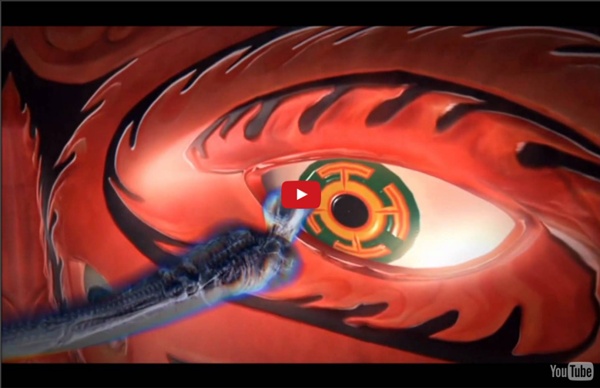



animations An experiental 3D-animation from my image of NGC 6752 I have tested a new method to publish my 3D-images as a form of Lenticular prints. For this technique to work, I need series of images from different angles, in this case 24 images are needed. Lenticular printing is actually an old technique but in past few years it has become much more sophisticated. The results can be stunning visually, image plane disappears and object floats in and outside of the frame. Since astronomical objects are too far away, no real parallax can be imaged. NOTE! A globular cluster, NGC 6752, as an animated 3D-study Please, let the image load, the size is ~6.5MB 24-frames, images are meant for a lenticular 3D-print. NOTE. Original 2D image of the object Image of the NGC 6752 from the year 2010 Original blog post, with technical info, can be seen here: What are globular clusters? First of all, they are very beautiful, visually and imaged! A screenshot from the 3D-modeling software
| HOT COFFEE, a documentary feature film Mirrors - JDSU (Photonics Handbook | Optical Materials & Coatings) A mirror is an important element in many optical systems. Its basic function is to redirect light, often with the purpose of making an optical system more compact. This article discusses the kinds of thin-film coatings that can be used for mirrors. The choice of coating depends on the application, including the spectral range of interest, the optical wavefront quality desired and the cost limitations. The basic difference between the household mirror and the optical mirror is that one is coated on the back surface and the other is coated on the front. A mirror’s substrate surface should be flat and smooth. For some applications, a mirror’s ability to conduct heat is important. Metal mirror coatings The simplest and most common mirror coating is a thin layer of metal. TABLE 1.n AND k FOR SELECTED METALS *Aluminum has a reflectance dip at 0.8 µm: for λ = 0.8 µm, n = 2.80 and k = 8.45 for λ = 0.9 µm, n = 2.06 and k = 8.30 SOURCE: Handbook of Optical Constants of Solids Figure 1. Figure 2. 1.
Phaistos Disc The Phaistos Disc (also spelled Phaistos Disk, Phaestos Disc) is a disk of fired clay from the Minoan palace of Phaistos on the Greek island of Crete, possibly dating to the middle or late Minoan Bronze Age (2nd millennium BC). It is about 15 cm (5.9 in) in diameter and covered on both sides with a spiral of stamped symbols. Its purpose and meaning, and even its original geographical place of manufacture, remain disputed, making it one of the most famous mysteries of archaeology. This unique object is now on display at the archaeological museum of Heraklion. The disc was discovered in 1908 by the Italian archaeologist Luigi Pernier in the Minoan palace-site of Phaistos, and features 241 tokens, comprising 45 unique signs, which were apparently made by pressing hieroglyphic "seals" into a disc of soft clay, in a clockwise sequence spiraling toward the disc's center. Discovery Tablet PH-1 It was found in the main cell of an underground "temple depository". Authenticity Dating Typography Signs
Écoles & universités De nous jours, les médias numériques sont omniprésents dans les études et la vie professionnelle. MAGIX soutient activement les écoles et les universités depuis de nombreuses années en mettant à disposition de manière optimale des compétences multimédias diversifiées. Les solutions complètes réalisées exclusivement pour les enseignants et les étudiants recouvrent tous les grands domaines d'application de la production de médias numériques : vidéo, musique, graphisme et webdesign. Profitez de : Solutions logicielles simples d'utilisation pour obtenir d'excellents résultats en un temps recordLicences multiples attrayantesQualité Made in GermanyFormations avancées compétentes dans tous les domaines du multimédia Venez visiter le portail d'éducation MAGIX
(1) Facebook la place du feu dans la mecanique quantique Hourglass Nebula The Engraved Hourglass Nebula (also known as MyCn 18) is a young planetary nebula situated in the southern constellation Musca about 8,000 light-years away from Earth. It was discovered by Annie Jump Cannon and Margaret W. Mayall during their work on an extended Henry Draper Catalogue (the catalogue was built between 1918 and 1924). At the time, it was designated simply as a small faint planetary nebula. Much improved telescopes and imaging techniques allowed the hourglass shape of the nebula to be discovered by Raghvendra Sahai and John Trauger of the Jet Propulsion Laboratory on January 18, 1996. The Hourglass Nebula was photographed by the Wide Field and Planetary Camera 2 of the Hubble Space Telescope. A less-famous "Hourglass Nebula" is located inside the Lagoon Nebula. Hourglass Nebula in popular culture[edit] See also[edit] Hourglass Nebula in fiction. References[edit] Coordinates:
Maps Utilisateurs d'un lecteur d'écran : cliquez ici pour accéder à la version HTML brut Nouveauté ! Faites glisser et déposez les icônes pour réorganiser vos applications. Connectez-vous pour essayer. PlusAutres résultats Google Connexion 100 m 500 pieds Satellite Trafic Photos Météo ferropolis Quitter Modifier dans Google Map MakerSignaler un problème Données cartographiques ©2014 GeoBasis-DE/BKG (©2009), Google - Ferropolis Ferropolisstraße 1, 06773 Gräfenhainichen, Allemagne · ferropolis.de 9 avis · ItinéraireRechercher à proximitéplus Google Maps - ©2014 Google - Conditions d'utilisation - Confidentialité Pour restituer le niveau de détail visible à l'écran, cliquez sur le lien "Imprimer" à côté de la carte. Pistes cyclables Voies réservées Routes empruntables à vélo
alive video